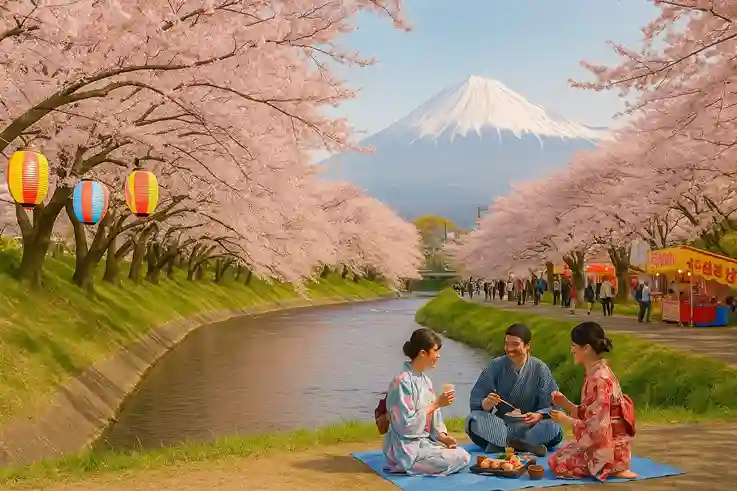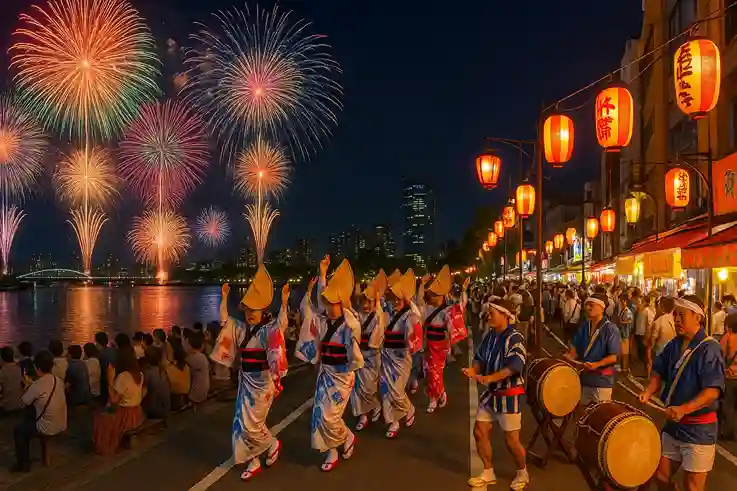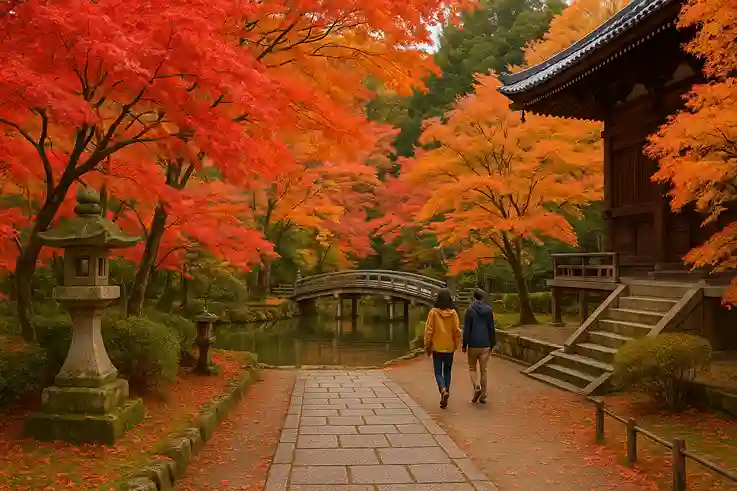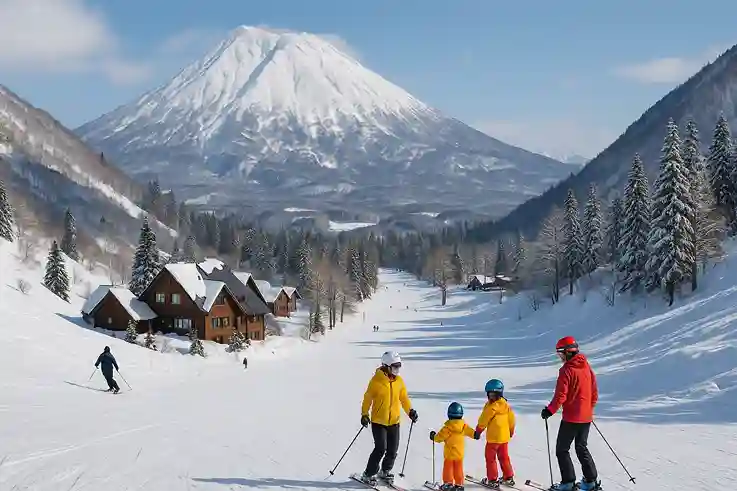The Best Time to Travel to Japan depends on what you want to experience. Each season highlights different attractions. Spring bursts with cherry blossoms and lively hanami celebrations. Streets glow pink, and locals gather outdoors to celebrate nature. However, this season attracts heavy crowds, so planning early is essential.
Summer shines with festivals, fireworks, and outdoor adventures. The heat and humidity challenge visitors, yet the vibrant energy makes up for it. Meanwhile, autumn delivers calm weather and colorful landscapes. Golden leaves transform temples and countryside into breathtaking scenes. Because crowds are smaller, travel feels relaxed and convenient.
Winter creates a snowy wonderland across Japan. Ski resorts attract adventurers, while hot springs offer quiet escapes. Also, dazzling illuminations brighten city nights and create magical views. Therefore, the best season depends on your interests. Each moment in Japan promises unique memories waiting to be made.
“In Japan, every season writes its own story — cherry blossoms in spring, fireworks in summer, golden leaves in autumn, and snow-draped temples in winter.”
Spring in Japan: Cherry Blossoms and Festivals

When to Visit
Cherry blossoms bloom mainly in March and April, marking Japan’s most famous travel season. The timing depends on location. Southern regions, like Kyushu, usually blossom in late March. Meanwhile, northern areas such as Hokkaido bloom several weeks later. This staggered schedule creates opportunities for travelers to chase the blossoms. However, exact peak days change each year. Therefore, many visitors check official forecasts before planning their trip to experience the blossoms at their best.
Cherry Blossom Experience
Sakura trees transform parks, gardens, and riversides into magical landscapes. Streets glow pink, and the air feels festive. Locals gather with friends and family for hanami picnics under falling petals. Travelers join them, enjoying food, drinks, and seasonal treats. However, these events attract huge crowds. Popular parks in Tokyo and Kyoto fill quickly. Therefore, booking hotels and train tickets early is important. With preparation, the hanami season becomes a truly unforgettable highlight of Japan.
Seasonal Events
Spring in Japan also highlights cultural festivals and traditional temple celebrations. Kyoto becomes especially lively, with dazzling parades showcasing colorful costumes and music. Meanwhile, Tokyo lights up its districts with glowing evening lanterns, creating a magical atmosphere after dark. Because of this festive mood, cities feel more vibrant than usual. Travelers can join local events, taste seasonal foods, and experience Japanese culture at its peak. Therefore, spring combines natural beauty with cultural excitement everywhere.
Pros and Cons of Spring Travel in Japan
| Aspect | Details |
|---|---|
| Pros | Magical cherry blossoms across the country. Vibrant festivals in Kyoto and Tokyo. Perfect weather for sightseeing. |
| Cons | Extremely crowded at popular spots like Ueno Park and Osaka Castle. Hotels and trains sell out quickly. Higher prices during peak bloom. |
| Tip | Plan early, book reservations in advance, and check blossom forecasts to avoid missing peak days. |
Summer in Japan: Festivals and Adventure

When to Visit
Summer in Japan runs from June to August, bringing long, warm days filled with activity. Temperatures rise steadily, and humidity can feel intense across cities. However, the season also carries unmatched excitement. Streets host lively gatherings, and festivals dominate the calendar. Travelers encounter both challenges and rewards. Therefore, packing wisely and pacing activities is essential. Despite the heat, energy fills the air, making summer unforgettable for those who embrace celebration and adventure.
Festivals and Fireworks
Summer in Japan is famous for its fireworks festivals, which attract millions every year. Tokyo Bay showcases massive displays, while Osaka hosts colorful shows over the river. Meanwhile, lively street parades bring together music, dancing, and traditional drumming. Costumes brighten the atmosphere, and performers fill the streets with energy. Because these festivals often last late into the night, travelers experience both tradition and excitement. For many, these events define the Best Time to Travel to Japan.
Mountain Adventures
The Japanese Alps open fully for hiking in summer, offering trails that lead to breathtaking peaks and crisp mountain air. Trekking routes range from gentle walks to challenging climbs, giving travelers options at every skill level. Because weather conditions are safer, many climbers attempt Mount Fuji during this season. Sunrise views from the summit are unforgettable. For adventure seekers, the Alps and Fuji together make summer the Best Time to Travel to Japan.
Beating the Heat
Humidity in Japan during summer can feel overwhelming, especially in cities like Tokyo and Osaka. Therefore, travelers should prepare carefully by packing light, breathable clothes and carrying water throughout the day. Cooling stations and shaded parks offer relief, while cold treats such as kakigori (shaved ice) bring refreshment. Also, planning outdoor activities early in the morning or evening helps avoid peak heat. With smart preparation, summer remains enjoyable and still the Best Time to Travel to Japan.
Why Choose Summer?
The Best Time to Travel to Japan may indeed be summer for travelers who thrive on energy and excitement. Festivals bring fireworks, parades, and street celebrations that showcase Japanese culture at its most vibrant. Meanwhile, mountains invite hikers to explore trails and climb Mount Fuji. Although humidity can feel intense, preparation makes the season manageable. Therefore, summer rewards adventurous spirits with experiences that blend nature, culture, and unforgettable memories across the country.
Pros and Cons of Summer Travel in Japan
| Aspect | Details |
|---|---|
| Pros | Spectacular fireworks festivals in Tokyo and Osaka. Lively street parades with music and dancing. Hiking in the Japanese Alps. |
| Cons | Intense humidity and high temperatures. Crowded festivals and busy trains. Higher costs during peak summer holidays. |
| Tip | Pack light clothes, carry water, and plan outdoor activities in mornings or evenings for comfort. |
Autumn in Japan: Stunning Foliage and Mild Weather

When to Visit
Autumn in Japan runs from September to November, offering some of the most pleasant conditions for travelers. Temperatures cool after summer’s heat, and the air feels crisp and refreshing. Meanwhile, landscapes transform dramatically. Trees across temples, gardens, and mountains shift into brilliant shades of red, orange, and yellow. Because the season progresses gradually, different regions peak at different times. Therefore, visitors can plan trips to follow the foliage and experience Japan’s beauty throughout autumn.
Colorful Foliage
Mountains, temples, and city parks glow with vibrant autumn leaves, creating some of Japan’s most iconic seasonal landscapes. Kyoto becomes breathtaking, with temples like Kiyomizu-dera framed by fiery reds and golds. Meanwhile, Nikko offers mountain scenery with cascading waterfalls surrounded by bright foliage. Therefore, both casual travelers and professional photographers find endless inspiration. The combination of cultural landmarks and natural beauty makes autumn unique. For many, these scenes define the Best Time to Travel to Japan.
Sightseeing and Photography
Crisp autumn air and bright skies make sightseeing especially enjoyable across Japan. Walking through gardens, temple grounds, and historic streets feels pleasant without the heavy heat of summer. Crowds are also lighter than in spring, allowing travelers to explore at a slower pace. Therefore, visiting famous spots like Arashiyama in Kyoto or Kenrokuen in Kanazawa feels more relaxed. With peaceful surroundings and colorful backdrops, autumn creates ideal conditions for photography and cultural exploration alike.
Why Choose Autumn?
The Best Time to Travel to Japan may be autumn for those who appreciate balance and beauty. Mild weather makes walking and sightseeing comfortable, while colorful scenery transforms even ordinary streets into works of art. Crowds are smaller compared to spring, creating peaceful moments at temples and gardens. Therefore, travelers can enjoy culture, food, and nature without the rush. For many, autumn combines the ideal mix of comfort, charm, and unforgettable seasonal experiences in Japan.
Pros and Cons of Autumn Travel in Japan
| Aspect | Details |
|---|---|
| Pros | Stunning foliage across mountains, temples, and city parks. Mild weather makes sightseeing comfortable. Smaller crowds than spring. |
| Cons | Popular foliage spots like Kyoto and Nikko can still feel busy. Peak foliage timing varies by region. |
| Tip | Check regional foliage forecasts and plan routes accordingly. Arrive early at famous sites for the most peaceful experience. |
Winter in Japan: Snow, Skiing, and Hot Springs

When to Visit
Winter in Japan lasts from December to February, creating a completely different travel atmosphere. Northern regions like Hokkaido receive heavy snowfall, covering mountains in deep powder. Because of this, the area has become one of the world’s top destinations for skiing and snowboarding. Meanwhile, Nagano and Niigata also welcome winter sports enthusiasts. With crisp air, snowy scenery, and festive towns, winter sets the stage for unique adventures that define the Best Time to Travel to Japan.
Skiing and Snow Adventures
Hokkaido and Nagano attract travelers worldwide with their famous ski resorts, offering some of the best powder snow conditions anywhere. Slopes cater to every level, from gentle beginner runs to thrilling expert courses. Resorts like Niseko, Hakuba, and Furano provide not only skiing but also snowboarding and snowshoeing. Therefore, winter sports become a highlight for many visitors. With modern facilities, cozy lodges, and breathtaking scenery, Japan’s ski destinations make winter the Best Time to Travel to Japan.
Hot Springs and Relaxation
Japan’s traditional hot springs, known as onsen, feel especially soothing during the cold winter months. Bathing outdoors while snow falls around the steaming water creates an unforgettable experience. Regions like Hakone, Beppu, and Kusatsu are famous for their natural hot spring resorts. Meanwhile, mountain villages offer rustic open-air baths with scenic views. Because onsens also reflect Japanese culture and rituals, they provide both relaxation and tradition. For many, winter onsen visits define the Best Time to Travel to Japan.
Winter Lights and Festivals
Illuminations brighten Japan’s cities each winter, turning streets, parks, and shopping districts into glowing wonderlands. Tokyo, Osaka, and Kobe host some of the most dazzling displays, drawing both locals and visitors. Meanwhile, New Year celebrations add a deep cultural layer. Families visit temples for hatsumode, the first prayer of the year. Seasonal foods such as osechi ryori and mochi also play a central role. Together, these traditions make winter feel like the Best Time to Travel to Japan.
Why Choose Winter?
The Best Time to Travel to Japan may be winter if you love snow, hot springs, and festive traditions combined. Ski resorts in Hokkaido and Nagano deliver world-class adventures, while steaming onsens offer peaceful relaxation. Meanwhile, sparkling illuminations and New Year celebrations provide cultural depth. Because this season blends excitement with comfort, it attracts both thrill-seekers and travelers seeking quiet escapes. For many, winter creates a magical balance of nature, tradition, and unforgettable experiences across Japan.
Pros and Cons of Winter Travel in Japan
| Aspect | Details |
|---|---|
| Pros | World-class ski resorts in Hokkaido and Nagano. Relaxing hot spring experiences. Dazzling illuminations and rich New Year traditions. |
| Cons | Cold weather may be challenging for some. Travel delays possible in snowy regions. Popular ski resorts can feel crowded. |
| Tip | Book ski resorts early. Pack warm layers and waterproof gear. Include onsen visits for comfort and balance during winter trips. |
Choosing the Best Time to Travel to Japan for You

Match Your Interests
The Best Time to Travel to Japan depends on what you enjoy most. Culture seekers may prefer spring, when cherry blossoms and hanami parties fill parks. Summer appeals to festival lovers, with fireworks, parades, and lively street performances. Meanwhile, autumn delights nature fans, offering golden temples, colorful foliage, and calm weather. Winter suits those who love skiing, hot springs, and seasonal traditions. Because each season highlights different activities, your choice should reflect personal passions.
Balance Budget and Crowds
Budget plays a major role in planning. Spring and summer bring high demand, so flights and hotels cost more. Festivals and cherry blossoms attract millions, creating crowded streets. Meanwhile, autumn is calmer, and winter offers good deals outside ski resorts. Therefore, travelers who value comfort and savings should consider visiting during these quieter months.
Recognize Seasonal Highlights
Every season has unique highlights. Spring blooms with pink petals and festive picnics. Summer explodes with energy, parades, and mountain hikes. Autumn glows with breathtaking foliage, offering perfect conditions for photography and sightseeing. Winter sparkles with powder snow, onsens, and New Year celebrations. Because of this variety, there is no single answer. The best season depends on your dream experiences.
Best Time to Travel to Japan: Seasonal Comparison
| Season | Months | Highlights | Drawbacks |
|---|---|---|---|
| Spring | March – May | Cherry blossoms, hanami picnics, cultural festivals, mild weather. | Heavy crowds, higher prices, limited hotel availability. |
| Summer | June – August | Fireworks festivals, street parades, hiking in the Alps, Mount Fuji climbs. | Intense humidity, crowded festivals, higher costs during holidays. |
| Autumn | September – November | Brilliant foliage, mild weather, peaceful sightseeing, lighter crowds. | Popular foliage spots still crowded, peak colors vary by region. |
| Winter | December – February | Skiing in Hokkaido and Nagano, relaxing hot springs, illuminations, New Year traditions. | Cold weather, snow delays, busy ski resorts. |
Visiting Japan | The Government of Japan — “General tourism information” page
Travel Tips for Planning Your Japan Holiday
Book Early for Peak Seasons
Spring and summer are the busiest travel periods. Cherry blossoms, festivals, and fireworks attract millions. Therefore, flights and hotels sell out fast. Booking early ensures better prices and availability.
Pack for Varied Weather
Japan’s climate changes quickly across regions. Northern areas can be snowy, while southern areas stay warm. Meanwhile, autumn brings crisp air, and summer can feel humid. Because of this, packing layers is essential. Lightweight clothes, jackets, and comfortable shoes make every trip easier.
Use Public Transport
Japan’s public transport system is efficient and reliable. Trains, buses, and subways connect cities and rural areas. The Japan Rail Pass offers value for longer stays. Meanwhile, local passes help with city travel. Using public transport saves money, reduces stress, and avoids traffic delays.
Stay Flexible
Weather and seasonal events can shift. Blossom peaks change, and festivals may vary. Therefore, keeping a flexible schedule allows adjustments. Travelers who adapt easily enjoy smoother holidays.
(FAQ) Best Time to Travel to Japan
Conclusion On Best Time to Travel to Japan
The Best Time to Travel to Japan truly depends on your personal goals and the type of experiences you value most. Spring is alive with cherry blossoms, hanami picnics, and colorful festivals. Summer bursts with energy, offering fireworks, parades, and outdoor adventures like climbing Mount Fuji. Autumn glows with breathtaking foliage and mild weather that makes sightseeing relaxed and comfortable. Winter sparkles with powder snow in Hokkaido, steaming hot springs, and cultural traditions during New Year celebrations.
Each season delivers something unforgettable, whether you care most about culture, food, festivals, or nature. Therefore, the real secret is choosing the season that best matches your dream holiday. With a little planning, flexibility, and curiosity, Japan will reward you with moments that last a lifetime.
💬 Which season would you choose for your ultimate Japan holiday? Share your thoughts in the comments below!

Adi holds a B.Sc. in Hospitality Management from the Institute of Hotel Management, bringing both academic knowledge and real-world experience to the table. Passionate about food, flavor, and the stories behind every dish, Adi writes to make culinary concepts approachable for everyone. From exploring global cuisines to highlighting simple kitchen techniques, the goal is always the same—help readers enjoy food more deeply and cook with confidence.


